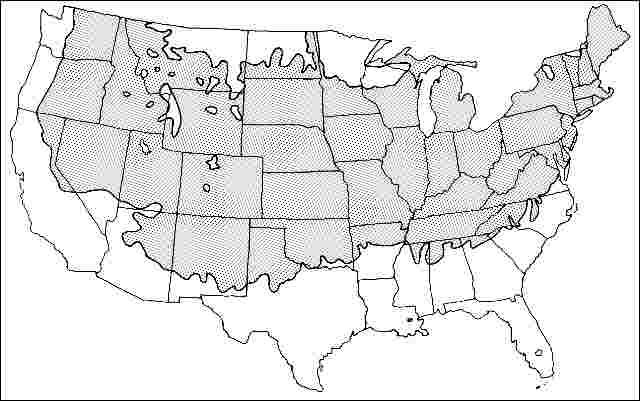Acer platanoides 'Summershade': 'Summershade' Norway Maple1
Introduction
'Summershade' Norway maple in cultivation has a height of 40 to 50 feet but can grow taller. The oval crown maintains a central leader and fills with greenish-yellow flowers in the spring. 'Summershade' Norway maple's dense shade and shallow root system compete with lawn grasses, and the shallow roots can make mowing under the tree difficult. Locate it in a bed with shrubs and groundcovers so the shallow roots will not cause a problem with mowing.

General Information
Scientific name: Acer platanoides
Pronunciation: AY-ser plat-uh-NOY-deez
Common name(s): 'Summershade' Norway maple
Family: Aceraceae
USDA hardiness zones: 4A through 7A (Fig. 2)
Origin: not native to North America
Invasive potential: invasive non-native
Uses: urban tolerant; specimen; screen; shade; street without sidewalk; parking lot island 100–200 sq. ft.; parking lot island > 200 sq. ft.; sidewalk cutout (tree pit); tree lawn 4–6 feet wide; tree lawn > 6 ft. wide; highway median; Bonsai
Availability: somewhat available, may have to go out of the region to find the tree

Description
Height: 40 to 60 feet
Spread: 35 to 50 feet
Crown uniformity: symmetrical
Crown shape: oval
Crown density: dense
Growth rate: fast
Texture: coarse
Foliage
Leaf arrangement: opposite/subopposite (Fig. 3)
Leaf type: simple
Leaf margin: lobed, dentate, incised
Leaf shape: star-shaped
Leaf venation: palmate
Leaf type and persistence: deciduous
Leaf blade length: 4 to 8 inches
Leaf color: green
Fall color: yellow
Fall characteristic: showy

Flower
Flower color: green
Flower characteristics: not showy
Fruit
Fruit shape: elongated
Fruit length: 1 to 3 inches
Fruit covering: dry or hard
Fruit color: brown, green
Fruit characteristics: attracts birds; showy; fruit/leaves not a litter problem
Trunk and Branches
Trunk/bark/branches: branches don't droop; not showy; typically one trunk; thorns
Pruning requirement: needed for strong structure
Breakage: resistant
Current year twig color: brown
Current year twig thickness: thick
Wood specific gravity: unknown
Culture
Light requirement: full sun, partial sun or partial shade
Soil tolerances: sand; loam; clay; acidic; alkaline; well-drained
Drought tolerance: moderate
Aerosol salt tolerance: moderate
Other
Roots: can form large surface roots
Winter interest: no
Outstanding tree: yes
Ozone sensitivity: unknown
Verticillium wilt susceptibility: susceptible
Pest resistance: resistant to pests/diseases
Use and Management
The tree is easily transplanted, grows more quickly than the species, is adapted to a wide variety of soils, and has brilliant yellow fall color. It can also tolerate coastal conditions and is adapted to street tree plantings. It is tolerant of urban conditions, including alkaline soil, drought and pollution. Norway maple can naturalize if located near open areas and roots can heave sidewalks, so locate it at least four to six feet away.
'Summershade' is probably the most heat tolerant of the Norway maples and ranked very high in shade tree trials in Ohio. Since it leafs out late in the spring it can be transplanted later than other cultivars. Seedlings germinate readily in the landscape and could become a weed problem in ground cover and shrubbery beds. Four or five types of birds are known to use seeds as a food source, so it might be best to locate the tree away from a park bench so bird droppings will not soil the bench. Trunks can crack on the southern or western sides during the winter.
A large number of other cultivars are available. Those having colored summer foliage are 'Crimson King—oval, 45 feet tall, foliage purple during the summer; 'Drummondii'—leaves edged in white; 'Schwedleri'—oval, 45 feet tall, foliage reddish in the spring then becoming green. Other cultivars are 'Almira'—round headed, mature height of about 20 feet; 'Cleveland'—upright growth habit, 50 feet tall; 'Columnare'—columnar or upright growth habit, 35 feet tall; 'Deborah'—new leaves appear as a deep red; 'Emerald Queen'—crown oval, growth rate faster, 60 feet tall; 'Erectum'—upright growth habit; 'Globosum'—rounded head, 20 feet tall; 'Greenlace'—cutleaf cultivar with rapid growth rate; 'Olmstead'—upright growth habit, 45 feet tall; 'Superform'—round, 45 feet tall, may show more resistance to frost cracks.
Pests
Aphids infest maples, usually Norway maple, and may be numerous at times. High populations can cause leaf drop. Another sign of heavy aphid infestation is honey dew on lower leaves and objects beneath the tree. Aphids are controlled by spraying or they may be left alone. If not sprayed, predatory insects will usually bring the aphid population under control.
Scales are an occasional problem on maples. Perhaps the most common is cottony maple scale. The insect forms a cottony mass on the lower sides of branches. Scales are usually controlled with horticultural oil sprays. Scales may also be controlled with well-timed sprays to kill the crawlers.
If borers become a problem it is an indication the tree is not growing well. Controlling borers involves keeping trees healthy. Chemical controls of existing infestations are more difficult. Proper control involves identification of the borer infesting the tree then applying insecticides at the proper time.
Diseases
It is susceptible to Ganoderma rot.
'Summershade' is susceptible to Verticillium wilt. Symptoms are wilting and death of branches. Infected sapwood will be stained a dark or olive green, but staining can't always be found. If staining can not be found, do not assume the problem is not verticillium wilt. Severely infected trees probably can't be saved. Lightly infected trees showing only a few wilted branches may be pulled through. Fertilize and prune lightly infected trees. This treatment will not cure the problem but may allow the tree to outgrow the infection. Girdling roots will cause symptoms that mimic verticillium wilt.


